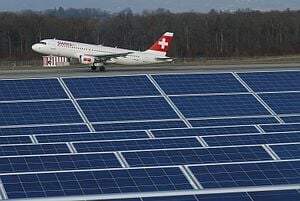J.M.Pearce (talk | contribs) m (→Keywords) |
Sophivorus (talk | contribs) m (Text replacement - "[[image:" to "[[Image:") |
||
| (14 intermediate revisions by 6 users not shown) | |||
| Line 1: | Line 1: | ||
{{Solar menu}} | |||
[[Image:airportpv.jpg|thumb]] | |||
{{MOST}} | {{MOST}} | ||
{{Source data | |||
[[ | | type = Paper | ||
| cite-as = Anurag Anurag, Jiemin Zhang, Jephias Gwamuri and Joshua M. Pearce. [http://www.mdpi.com/1996-1073/10/8/1194 General Design Procedures for Airport-Based Solar Photovoltaic Systems]. ''Energies'' 2017, 10(8), 1194; doi:10.3390/en10081194 [https://www.academia.edu/34229000/General_Design_Procedures_for_Airport-Based_Solar_Photovoltaic_Systems open access] | |||
}} | |||
A source of large surface areas for solar photovoltaic (PV) farms that has been largely overlooked in the 13,000 United States of America (U.S.) airports. This paper hopes to enable PV deployments in most airports by providing an approach to overcome the three primary challenges identified by the Federal Aviation Administration (FAA): (1) reflectivity and glare; (2) radar interference; and (3) physical penetration of airspace. First, these challenges and precautions that must be adhered to for safe PV projects deployment at airports are reviewed and summarized. Since one of the core concerns for PV and airport symbiosis is solar panel reflectivity, and because this data is largely estimated, a controlled experiment is conducted to determine worst-case values of front panel surface reflectivity and compare them to theoretical calculations. Then a general approach to implement solar PV systems in an airport is outlined and this approach is applied to a case study airport. The available land was found to be over 570 acres, which would generate more than 39,000% of the actual annual power demand of the existing airport. The results are discussed while considering the scaling potential of airport-based PV systems throughout the U.S. | |||
{{Pearce publications notice}} | |||
== | == Keywords == | ||
airport; [[photovoltaic]]; [[solar energy]]; glare; Federal Aviation Administration; [[economics]]; Solar farm | airport; [[photovoltaic]]; [[solar energy]]; glare; Federal Aviation Administration; [[economics]]; Solar farm | ||
==Method== | == Method == | ||
* [https://sam.nrel.gov/ System Advisor Model ] | * [https://sam.nrel.gov/ System Advisor Model ] | ||
==See also== | == See also == | ||
* [[Dual use of land for PV farms and agriculture literature review]] | * [[Dual use of land for PV farms and agriculture literature review]] | ||
* [[Technical Solar Photovoltaic Potential of Scaled Parking Lot Canopies- A Case Study of Walmart U.S.A.]] | * [[Technical Solar Photovoltaic Potential of Scaled Parking Lot Canopies- A Case Study of Walmart U.S.A.]] | ||
* [[Aquavoltaics: Synergies for dual use of water area for solar photovoltaic electricity generation and aquaculture]] | * [[Aquavoltaics: Synergies for dual use of water area for solar photovoltaic electricity generation and aquaculture]] | ||
* [[The potential of agrivoltaic systems]] | * [[The potential of agrivoltaic systems]] | ||
* [[Agrivoltaic potential on grape farms in India]] | |||
* [[An open source simulation of photovoltaic yield with r.sun over large regions]] | * [[An open source simulation of photovoltaic yield with r.sun over large regions]] | ||
{{ | * [https://spectrum.ieee.org/energywise/energy/renewables/airports-go-electric-and-renewables-are-on-the-radar Dutch Will Use Wind Power to Green Airports, But Solar is the Future Elsewhere] | ||
* [[Coal with Carbon Capture and Sequestration is not as Land Use Efficient as Solar Photovoltaic Technology for Climate Neutral Electricity Production]] | |||
* [[Conceptual Design and Rationale for a New Agrivoltaics Concept: Pastured-Raised Rabbits and Solar Farming]] | |||
{{Page data | |||
| title-tag = Design Procedures for Airport Solar PV Systems | |||
}} | |||
[[Category:MOST completed projects and publications]] | [[Category:MOST completed projects and publications]] | ||
[[Category:Solar energy]] | [[Category:Solar energy]] | ||
[[Category:Photovoltaics]] | [[Category:Photovoltaics]] | ||
Latest revision as of 19:04, 16 April 2024

A source of large surface areas for solar photovoltaic (PV) farms that has been largely overlooked in the 13,000 United States of America (U.S.) airports. This paper hopes to enable PV deployments in most airports by providing an approach to overcome the three primary challenges identified by the Federal Aviation Administration (FAA): (1) reflectivity and glare; (2) radar interference; and (3) physical penetration of airspace. First, these challenges and precautions that must be adhered to for safe PV projects deployment at airports are reviewed and summarized. Since one of the core concerns for PV and airport symbiosis is solar panel reflectivity, and because this data is largely estimated, a controlled experiment is conducted to determine worst-case values of front panel surface reflectivity and compare them to theoretical calculations. Then a general approach to implement solar PV systems in an airport is outlined and this approach is applied to a case study airport. The available land was found to be over 570 acres, which would generate more than 39,000% of the actual annual power demand of the existing airport. The results are discussed while considering the scaling potential of airport-based PV systems throughout the U.S.
Keywords[edit | edit source]
airport; photovoltaic; solar energy; glare; Federal Aviation Administration; economics; Solar farm
Method[edit | edit source]
See also[edit | edit source]
- Dual use of land for PV farms and agriculture literature review
- Technical Solar Photovoltaic Potential of Scaled Parking Lot Canopies- A Case Study of Walmart U.S.A.
- Aquavoltaics: Synergies for dual use of water area for solar photovoltaic electricity generation and aquaculture
- The potential of agrivoltaic systems
- Agrivoltaic potential on grape farms in India
- An open source simulation of photovoltaic yield with r.sun over large regions
- Dutch Will Use Wind Power to Green Airports, But Solar is the Future Elsewhere
- Coal with Carbon Capture and Sequestration is not as Land Use Efficient as Solar Photovoltaic Technology for Climate Neutral Electricity Production
- Conceptual Design and Rationale for a New Agrivoltaics Concept: Pastured-Raised Rabbits and Solar Farming





